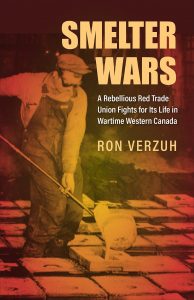Smelter Wars
 Smelter Wars: A Rebellious Trade Union Fights for Its Life in Wartime Western Canada, by Ron Verzuh (Toronto: University of Toronto Press, 2022)
Smelter Wars: A Rebellious Trade Union Fights for Its Life in Wartime Western Canada, by Ron Verzuh (Toronto: University of Toronto Press, 2022)Trail is a city in British Columbia, just north of the border between the United States and Canada. Along the Columbia River, it is home to the Consolidated Mining and Smelting Company of Canada and what had been for thirty years Local 480 of the International Union of Mine, Mill, and Smelter Workers (Mine-Mill), which in 1967 merged with the United Steel Workers of America. The union is the subject of the present meticulous, highly detailed study by Ron Verzuh, a native of Trail, who had earlier worked, as had others in his family, for the company. Verzuh also studied at Simon Fraser University and produced a doctoral dissertation which became the basis for this book. As author of two other works on Canadian radicals, he was especially qualified to write on Local 480 and its radical unionism.
Against a backdrop of the Cold War and the Second Red Scare, Verzuh tells of a union under siege and torn between an array of strong-willed characters. Among them were Selwyn G. Blaylock, president of the company, who tenaciously pursued the cause of company unionism by forming a Workmen’s Co-operative Committee. Opposing him were Communist leaders of the union, such as Arthur Evans, Al King and Harvey Murphy, the “reddest rose in labour’s garden,” as he described himself, who led it through several decades of turmoil.
The story is complex, involving a community of twenty-six politically polarized nationalities, the anti-communist Roman Catholic church, and the anti-communist United Steel Workers. Rather than spur unity at home, the Second World War brought greater division, that extended even into the Cold War era and involved noted American singer and actor Paul Robeson. With support from Mine-Mill, Robeson, whose United States passport had been revoked, presented four concerts on the border of Washington State and British Columbia.
As the author explains, the “wars” of his book’s title were not bomb and bullet affairs, but conflicts “driven by competing ideologies.” Trail and its smelter “was [sic] once the battlefield for those wars” that produced “years of confrontation between a trade union once led by Communists and a powerful industrial empire.” Though the particulars of the seemingly endless battles between the two sides are at times difficult to follow in Verzuh’s pages, he conscientiously guides the reader through the book’s years of coverage by citing contemporary motion pictures, radio programs, and events. These citations are a constant and welcome reminder of the society that functioned during the labor strife.
Nevertheless, Local 480 continued to combat social injustice and consequently encounter criticism in the early 1950s, the heyday of McCarthyism, above as well as below the border between Canada and the United States. Defying the critics of its left-wing leadership, in 1954 the union sponsored the showing of a motion picture drama, Salt of the Earth, that depicted a fictitious strike by zinc workers in New Mexico. Sponsored by Mine-Mill, it was produced by blacklisted filmmakers and banned in the United States. Clearly sympathetic to the union, Verzuh reveals the controversy that surrounded the public showing of Salt in the Kootenay region of British Columbia.
Highly detailed and requiring close concentration, Smelter Wars impresses with its depth of research. Though at first glance it appears to be a tightly written history of a union local, further examination reveals it to be a spotlight on a corner of the Cold War. Based on union and company, private and public primary sources, including police files, memoirs and specialized studies, the book is a model of scholarship.
In a delightful epilogue, Verzuh provides a snapshot of Trail in 2021. Long a company town, it had since come to resemble “a sleepy provincial town.” Returning to his town, he found numerous vestiges of its fractious past, “diminished perhaps but still supporting an admirable level of job security.” He notes the decline of organized labor in Canada as well as the United States in recent decades and is not optimistic that it will readily rebound to “successfully “challenge modern-day capitalism.” Its revival he suggests requires a return to the spirit displayed by Mine-Mill Local 480 that his study diligently describes.
Reviewed by Robert D. Parmet, York College, The City University of New York
